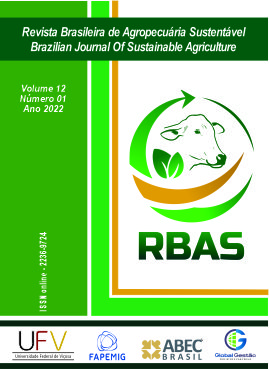DRY MATTER AND PROTEIN ACCUMULATION AS A FUNCTION OF NITROGEN FERTILIZATION IN Brachiaria brizantha CV. MARANDU (Urochloa brizantha)
DOI:
https://doi.org/10.21206/rbas.v12i1.13125Palavras-chave:
forragicultura, nutrição mineral, pecuária de leite, silagem.Resumo
In Brazil, forage is the main source of nutrients for ruminants, but most production systems are extensive and low amounts of inputs are used to improve soil fertility. This study aimed to evaluate the effect of nitrogen doses on dry matter yield and protein content in leaves, stems and shoots of Brachiaria brizantha cv. Marandu. The soil was fertilized with dolomitic limestone and gypsum to raise base saturation to 60% in the 0-20 cm layer and decrease exchangeable aluminum in the subsurface layer. The experimental
design was the randomized blocks with four replications, and the plots were five meters long by five meters wide. Nitrogen fertilization doses were 0 (control), 50, 100, 150, 200 and 250 kg of N ha-1, and applied on the soil surface at the beginning of the regrowth period. Phosphate and potassium fertilization of 50 kg P ha-1 and 150 kg K ha-1 were also carried out. Plants were cut thirty-seven days after fertilization. The evaluations were carried out in the central 9.0 m2 of the plot. A positive effect of nitrogen fertilization was found on all the variables assessed in the study. The effect was linear for fresh matter and dry matter accumulation in leaves + stems of Brachiaria brizantha cv. Marandu. The accumulation of dry matter in leaves + stems was 4.46 t ha-1 in the control treatment, increasing to 6.03 t ha-1 at the highest nitrogen dose. Nitrogen fertilization positively influenced the percentage accumulation of dry matter in leaves of Brachiaria brizantha cv. Marandu, achieving the equation Y= 25.529 + 0.0372x. Consequently, there was a percentage reduction in the dry matter allocated in stems. At the highest nitrogen dose, the percentage increase of dry matter in leaves was 17%. The
effect of nitrogen fertilization on protein content in leaves, stems and leaves + stems was also found. At the highest nitrogen dose (250 kg of N ha-1), there was an increase in protein per kg of dry matter of 86.78 g, as content in the control treatment was 67.5 g kg-1, increasing to 154.3 g kg-1. In addition to increasing the yield due to dry matter accumulation in the plant and improving the bromatological quality, nitrogen fertilization also increased protein production. We should also note that there was an increase in yield and protein production per hectare with the highest dose of nitrogen fertilization.
Downloads
Downloads
Publicado
Como Citar
Edição
Seção
Licença
Copyright (c) 2022 Revista Brasileira de Agropecuária Sustentável

Este trabalho está licenciado sob uma licença Creative Commons Attribution-NonCommercial-NoDerivatives 4.0 International License.
1. Proposta de Política para Periódicos de Acesso Livre
Autores que publicam nesta revista concordam com os seguintes termos:
Autores mantém os direitos autorais e concedem à revista o direito de primeira publicação, com o trabalho simultaneamente licenciado sob a Licença Creative Commons Attribution que permite o compartilhamento do trabalho com reconhecimento da autoria e publicação inicial nesta revista.












